Robert Woodward (architect)
Robert Raymond (Bob) Woodward AM (5 June 1923 – 21 February 2010) was an Australian architect who gained widespread recognition for his innovative fountain designs.[2][3][4][5]
Robert Woodward | |
|---|---|
| Born | 5 June 1923[1] |
| Died | 21 February 2010 (aged 86)[2] |
| Nationality | Australian |
| Occupation | Architect |
| Projects | |
Background and early career
Robert Raymond Woodward was born in Wentworthville in Sydney's western suburbs, the son of a public service accountant. Woodward was educated at Granville Technical Granville and Sydney Technical College.[6] He served in the army during World War II working as an armourer.[7] He was initially stationed with the Lachlan Macquarie 54th Regiment in Bathurst, then at Victoria Barracks where he completed an armoury course at East Sydney Technical College. Woodward later explained that being in the army at a young age had taught him to be responsible for the work he was doing and how to give instructions effectively.[8] It also opened up the opportunity to study architecture at the University of Sydney after the war as part of the huge post-war repatriation intake of ex-servicemen.[5]
Woodward commenced his architectural degree in 1947 and was impressed by teachers such as Leslie Wilkinson, George Molnar and Lloyd Rees. As a student he worked for Harry "Pergola" Divola and Peddle Thorp & Walker, while in 1950 he represented Australia in the 440 yard hurdles at New Zealand's British Empire Games.[1][9] After graduating with honours in 1952 he joined the Royal Australian Institute of Architects and worked briefly for Peddle Thorp & Walker, detailing industrial buildings, but soon headed off for England. He toured Europe with friends from Sydney before settling in Finland where he was privileged to work for a year with Alvar Aalto. He also spent another year in Finland working for the firm of Viljo Revell.[5][10][6] Upon his return he went into partnership, forming Woodward, Taranto and Wallace, specialising in commercial and industrial architecture.[10]
Woodward considered that architectural education in Finland was impressive in the way that it demanded that its students actually build structures. He considered that "architects need to understand materials" and was impressed by 'Aalto's multi-disciplinary approach where landscape is involved in the building, and interior design, lighting, furnishings, fabrics... I think Aalto's main contribution, and this is to put it very simplistically ... was that he was able to get the best of Bauhaus as well as organic work... Aalto's principles, as stated by him, are that essentially everything in architecture is related to biology. If you take a leaf from a tree, for example, you can see... design principles which should apply to architecture itself. The first item is cellular structure which Aalto saw as the cells being spatial - not physical elements put together but spaces, and a leaf is made up of a whole multitude of similar cells. They mightn't be the same but they are similar and from one family. The way they are structured together is a flexible combination of those elements - cellular structure, flexible combination and the repetition...'[11][5]
Woodward returned to Sydney in 1954 where he had some job offers from big firms, but instead formed a small partnership with Phil Taranto in Bankstown, they were later joined by Scott Wallace. They worked on small scale sites like a fruit shop in Bankstown, where they rationalized the work spaces, designed light fittings and introduced mirrored walls to increase the impression of light and plenty - innovations which were widely "copied and mass produced".[12][5]
Landscape architecture
In 1959, Woodward submitted a design to a City of Sydney competition to construct a fountain in Kings Cross, mainly as a professional "design exercise" for himself.[13] The design commemorated the war service of the 9th Division of the Second Australian Imperial Force. He won the competition in the name of his firm Woodward & Taranto and went on to build the El Alamein Memorial Fountain,[14] as it became known, was completed in 1961.[3] Combining his architectural and earlier metalwork training he developed the "dandelion" inspired fountain which became one of the world's most copied designs.[10] The fountain won the New South Wales Institute of Architects Civic Design Award in 1964. This was an immediate success and led to the gradual reorientation of his career into national and international prominence as a fountain designer. In 1968 the Woodward Taranto Wallace partnership was dissolved and Woodward continued alone as a sole practitioner with a focus on fountain design, joining the Australian Institute of Landscape Architects in 1989. He is responsible for many of the most prominent and admired fountains in Australia.[5]
In his oral history interview with Hazel de Berg in 1972, Woodward stated:[15]
'I like water very much, it's a fine medium to work in, a little difficult of course, one can't put it in a lathe or shape it as you do with metals, or forge it or cast it, but those difficulties themselves are what give it its main charm, I think, it's a medium to work in, a sculptural medium, it has form, it has transparency, it reflects light, has movement. It has constantly changing form, although one can control it. One can control the general form and let natural variations of water flow or wind or lighting variations give added charm and character whilst still directing the general form. '
Woodward suggested that he didn't restrict himself to fountain design, as he explained to De Berg:[16][5]
'The reason I do mostly fountain work and sculptural work now is . . . [it] is the most interesting work that is available. I'm working free-lance and I don't mind what the work is as long as it is interesting and I can achieve some result. . . there is a whole range of things that can be done and fields I would like to work in. As an example, there is the transport system, I would dearly love to have a commission just to re-plan in all respects our transport system for this state. . . The limitations, of course, are political and commercial ones, they'd be the ones I'd find it very difficult to overcome but if it was just from a design point of view only, I'd be delighted to take on a commission of that nature'.
Due to the success of this fountain, Woodward was approached for further commissions for fountain designs, significantly altering his career path.[6] In 1979, he created the Canberra Times fountain, commissioned for the newspaper's fiftieth anniversary.[6] Following this, he was commissioned to design a fountain for the High Court of Australia in Canberra, a cascade beside the ceremonial ramp.[6] In 1981, he completed a fountain for G.J. Coles and Coy for the Parliament Reserve in Melbourne.[17]
The Darling Harbour Water Feature outside the Sydney Exhibition Centre completed in 1988 was one of Woodward's most important works. It was a beautiful piece of design with its interplay of water, light and surface texture. It is both an irresistibly interactive water element and beautiful spiral sculptural form.[5]
Woodward was the recipient of many awards and honours in his lifetime, including the NSW Institute of Architect's Civic Design Award for the El Alamein Fountain in 1964, and in 1991 ACT Chapter RAIA Canberra Medallion, for New Parliament House, the 1991 NSW Chapter Civic Design Merit Award for Darling Harbour, the 1991 RAIA Walter Burley Griffin Award for Darling Harbour, the 1991 RAIA Civic Design Award for Darling Harbour, and the 1992 AILA National Awards in Landscape Architecture Civic Design Project Award.[5]
In 1987 he was appointed a Member of Order of Australia for his services to architecture and fountain design.[5]
Selected works by Robert Woodward
- El Alamein Memorial Fountain Kings Cross, Sydney 1959
- St Paul's Church Wentworthville, Sydney 1964
- Alcoa Forecourt Fountain San Francisco 1967
- Archibald Memorial Fountain, Restoration of 1933 fountain, Hyde Park, Sydney 1968
- Bank of California Fountain Portland, Oregon 1969
- Geyser Room Restaurant, New Zealand Pavilion, Expo 70 Osaka 1970
- Tupperware Forecourt Fountain Orlando, Florida 1970
- Chifley Square Fountain Sydney 1971
- Grace Memorial Fountain, Roselands Campsie, Sydney 1972
- Berger Foundation Fountain Minneapolis 1975
- Wall of Water, Sydney Square Town Hall, Sydney 1976
- Blue Wave Ceramic Sculpture, Bondi Junction Plaza Sydney 1977
- Mini El Alamein Fountain, Perak Turf Club Ipoh, Malaysia 1978
- Canberra Times Fountain Canberra 1979
- Forecourt Cascades, High Court of Australia Canberra 1980
- Five Islands Fountain donated by the Illawarra Mercury, Wollongong 1981
- G.J. Coles Fountain, Parliament Gardens, Melbourne 1981
- Lane Cove Plaza Proposal Lane Cove, Sydney 1981
- Mount Street Doughnuts North Sydney 1982
- New South Wales Parliament House Courtyard Fountain Sydney 1983
- Lyric Theatre Fountain, Queensland Performing Arts Centre Brisbane 1984
- Palmerston City Square Fountain Darwin 1985
- Pacific Bell Forecourt Fountain San Ramon, California 1988
- Australian Parliament House Forecourt Canberra 1988
- Darling Harbour Water Feature outside Convention Centre Sydney 1988
- Modular Spiral Stair, precast Bankstown[5]
Selected works
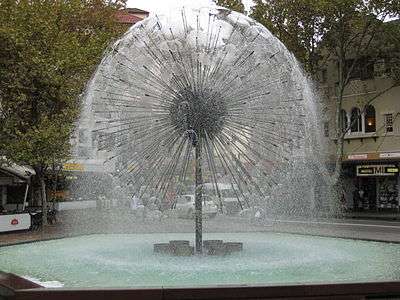 El Alamein Memorial Fountain, Kings Cross (1961)
El Alamein Memorial Fountain, Kings Cross (1961)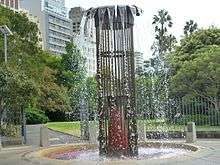 Morshead Fountain in the Royal Botanic Garden, Sydney (1966)
Morshead Fountain in the Royal Botanic Garden, Sydney (1966)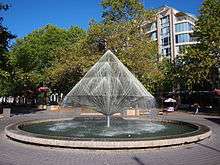 The Canberra Times Fountain, Canberra (1979)
The Canberra Times Fountain, Canberra (1979)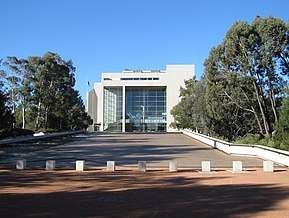 Cascade at the High Court of Australia in Canberra (1980)
Cascade at the High Court of Australia in Canberra (1980) Fountain at NSW Parliament House, Sydney (1983)
Fountain at NSW Parliament House, Sydney (1983)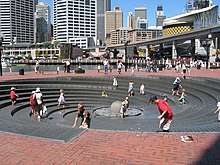 Darling Harbour Water Feature, Darling Harbour (1988)
Darling Harbour Water Feature, Darling Harbour (1988)
References
- "Robert Woodward (NSW)". Australian Athletics Historical Results. Athletics Australia. Archived from the original on 20 October 2009. Retrieved 16 March 2010.
- "Woodward, Robert Tribute". Fairfax Digital. Archived from the original on 16 April 2010. Retrieved 15 March 2010.
- "Robert Woodward - Australian fountain designer". Landscape Australia. 3: 240. August 1982.
- "Robert Woodward interviewed by Hazel de Berg in the Hazel de Berg collection (sound recording)". catalogue. National Library of Australia. Retrieved 15 March 2010.
- "Darling Harbour Woodward Water Feature". New South Wales State Heritage Register. Office of Environment and Heritage. H01933. Retrieved 14 October 2018.
- Neale, Ralph (July 1979). "Robert Woodward fountain sculptor". Landscape Australia. 3: 155–160.
- Jones, Caroline Viera (16 March 2010). "Armourer and architect designed the El Alamein Fountain". The Age. Retrieved 16 March 2010.
- de Berg, 1972.
- "1950 Australian Team and Results" (PDF). Australian Commonwealth Games Association. Archived from the original (PDF) on 2 October 2009. Retrieved 15 March 2010.
- "People in this issue". Landscape Australia. 3: 117. July 1979.
- Johnson, 1996, pp189-190
- Johnson, 1996, p193
- Johnson, 1996, p194
- Howlin, Jan (November 2006). "Luminary: Robert Woodward". indesign. Indesign Publishing. p. 126. Retrieved 22 March 2010.
- De Berg, 1972, p7111
- De Berg, p7112, 7122-3
- "Coles Fountain". eMelbourne. University of Melbourne. Retrieved 15 March 2010.
Bibliography
- Robert Woodward - Australian fountain designer (Landscape Australia, Aug 3). 1982.
- Water Feature at Darling Harbour in Landscape Australia 4. Australian Institute of Landscape Architects Jury. 1992.
- Australian Institute of Architects. Nomination.
- Goad, Philip; Willis, Julie, eds. (2011). The Encyclopaedia of Australian Architecture.
- de Berg, Hazel (1972). Robert Woodward Oral History.
- Mossop, Helen (2006). Contemporary Australian Landscape Design.
- Taylor, Jennifer (1990). Australian Architecture Since 1960.
- Webber, Prof Peter (1988). The Design of Sydney.
Attribution
![]()
External links
- Sculptors Society (Sydney) website, with photographs, architectural drawings, and 3 essays.